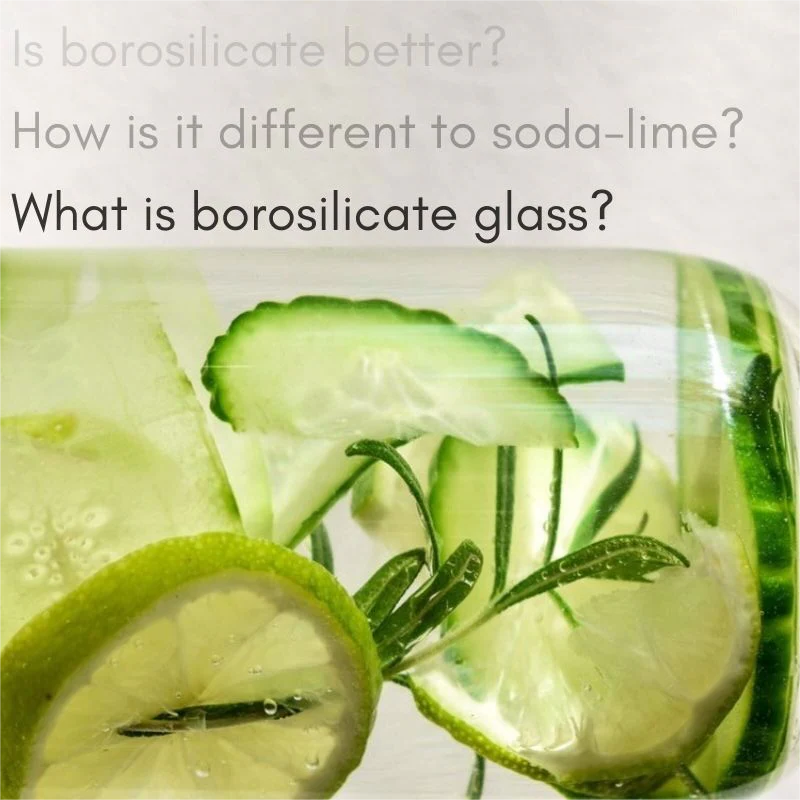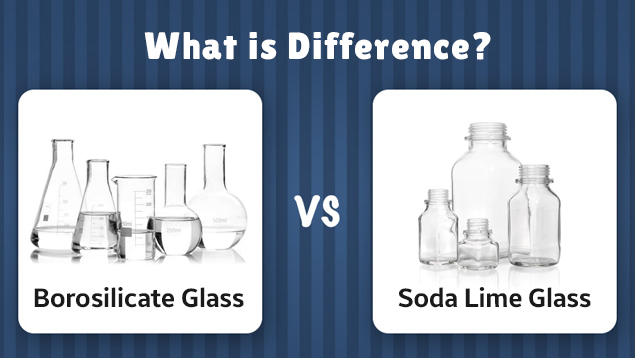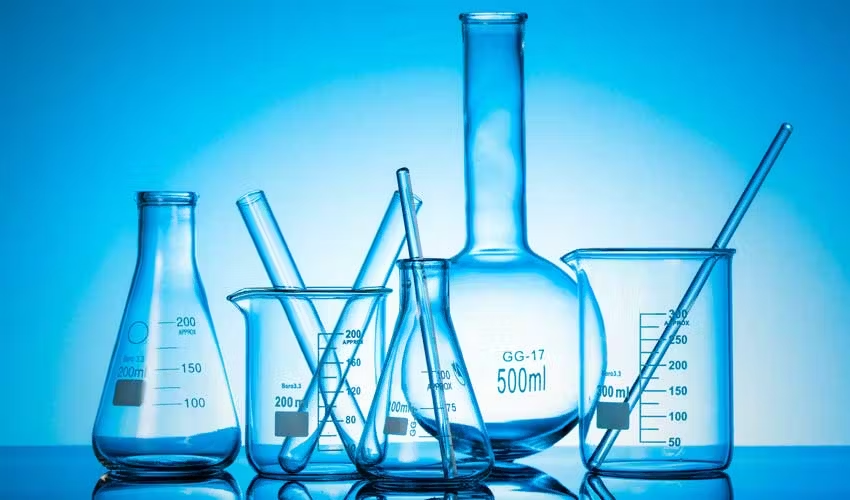Borosilicate glass is a type of glass made by adding boron oxide to the standard silica–soda–lime mix, which gives it a distinct set of physical and chemical properties. Compared with ordinary (soda-lime) glass, borosilicate is far more resistant to thermal shock and chemical corrosion, meaning it can handle rapid temperature changes and exposure to acids or alkalis without cracking or leaching. These traits make it the preferred material for laboratory glassware, high-quality cookware, and technical packaging where durability and inertness matter. In this article we’ll explain what borosilicate is, how it differs from regular glass, and why those differences matter for manufacturers and end users.
What Is Borosilicate Glass?
Borosilicate glass is a type of engineered glass whose formula is shifted toward silica and boron oxide so it behaves very differently from ordinary soda-lime glass. Typical mixes run roughly 65–80% silica (SiO₂) with 8–25% boron trioxide (B₂O₃), plus small amounts of sodium oxide and aluminum oxide to make it easier to form and stronger in use. In plain terms: the boron lowers the melting and softening points and cuts down how much the glass expands when heated, while the other additives help with workability and mechanical strength.
Those changes in chemistry give borosilicate a distinctive set of practical properties. It has a low coefficient of thermal expansion (around 3.0–4.3 × 10⁻⁶/°C), which is why it resists thermal shock and can tolerate rapid temperature swings that would crack regular glass. It also holds up well to many chemicals, keeps clarity over time, and offers higher mechanical durability and electrical resistance than typical container glass. Typical working temperatures fall somewhere between 300–500°C, with a melting range around 1250°C.
Common uses reflect these strengths: laboratory glassware, medical ampoules, high-quality cookware, lighting/electronic components, and demanding industrial sight glasses. Because of its heat resistance, chemical stability, and toughness, borosilicate is the go-to choice whenever reliability under stress matters.
What Is Soda-lime (regular) Glass?
Soda-lime glass is the everyday glass used for windows, bottles, jars and most common household items. It’s made from a silica-based mix with added soda (sodium oxide) and lime (calcium oxide) to make the material easier to melt and shape at factory temperatures.
Soda-lime glass is clear, rigid and glassy but relatively brittle. It expands more with heat than borosilicate does, so sudden temperature changes can cause cracking. It also has only moderate chemical resistance and can slowly leach or degrade with long exposure to very acidic or alkaline environments. On the upside, it’s inexpensive, easy to color or coat, and works well for large-scale, low-cost products.
Typical uses: Windows, beverage and food containers, tableware, common lighting and many architectural applications. When more strength or safety is needed, manufacturers turn to treated forms of soda-lime—tempered or laminated glass—rather than changing the base chemistry. Those treatments improve impact resistance and reduce dangerous breakage patterns while keeping the basic advantages of soda-lime glass.
Superior thermal shock resistance
Borosilicate glass stands out because it changes very little with temperature — its coefficient of thermal expansion is about 3 × 10⁻⁶ K⁻¹. That low expansion means heating or cooling creates much smaller internal stresses than in soda-lime glass (which expands roughly three times as much), so borosilicate is far less likely to crack when exposed to rapid temperature swings. In practice it can tolerate quick changes on the order of 170°C (330°F) and is rated for continuous use at temperatures up to about 500°C, with a softening point near 820°C.
The practical result is fewer failures and longer life in applications where heat changes are routine. Because it resists thermal shock, borosilicate keeps both safety and performance where ordinary glass would risk breakage.
Better chemical resistance
Borosilicate (type 3.3) is chosen when the product must sit next to aggressive chemicals for long periods. Its composition makes it far less reactive than soda-lime glass: it resists salts, most organic solvents and many strong acids with almost no change in clarity or wall thickness over time. That resistance is why labs and chemical plants use it where contamination or corrosion would be a problem.
It’s not invincible — hydrofluoric acid, very concentrated phosphoric acid and hot, concentrated alkalis attack glass — but for routine acids, saline solutions and caustic solutions at ambient temperatures it performs reliably. In practical terms, borosilicate can store up to roughly 30% caustic solutions at room temperature for years without visible thinning, and wear from strong acids (for example concentrated HCl) is measured in only a few thousandths of a millimeter per year. International tests also put borosilicate at the top hydrolytic classes (ISO 719 / ISO 720).
Because it stays chemically stable and inert in contact with many harsh substances, borosilicate is the safer, longer-lasting choice where chemical exposure is routine.
Stronger and harder — why borosilicate is the safer choice
Borosilicate glass is mechanically tougher than ordinary soda-lime glass. Its chemistry and internal structure make it more resistant to crushing, bending and surface wear, so it tolerates rough handling and heavy use with fewer failures. In practical terms this shows up as noticeably higher load capacity, better resistance to scratching, and greater ability to blunt or stop small cracks before they run.
Compared with standard container glass, borosilicate typically delivers a meaningful uplift in compressive and flexural strength, a higher hardness rating that resists abrasion, and improved fracture toughness — enough to reduce breakage in labware, cookware and industrial sight windows. Those gains aren’t just for testing labs: they translate into fewer replacements, lower downtime, and safer equipment in everyday use.
At-a-Glance Table: Borosilicate vs. Regular Glass
|
Property |
Borosilicate Glass |
Regular (Soda-Lime) Glass |
|---|---|---|
|
Compressive Strength |
up to 2000 MPa |
500–1000 MPa |
|
Flexural Strength |
34–69 MPa |
~30–50 MPa |
|
Elastic Modulus |
67–80 GPa |
~60–70 GPa |
|
Knoop Hardness |
510 |
~400 |
|
Fracture Toughness |
0.8 MPa·m^1/2 |
~0.6 MPa·m^1/2 |
|
Thermal Shock Resistance |
High (160°C differential) |
Low–moderate |
|
Impact & Scratch Resistance |
Superior |
Lower |
In short, when durability under mechanical stress matters, borosilicate gives longer life and more reliable performance than regular glass.
Lighter and clearer — why that matters
Borosilicate glass is noticeably less dense than typical soda-lime glass (about 2.2–2.4 g/cm³ vs 2.4–2.8 g/cm³). That lower weight makes items easier to handle and less tiring for technicians and users — a practical advantage for lab glassware, bakeware, and instruments that are moved or adjusted frequently.
Optically, borosilicate is also superior. With lower iron content it shows much less of the green tint common in ordinary glass, so it looks clearer and transmits more light across a wide range (including near-UV to IR). Its refractive index (roughly 1.47–1.50) and a high Abbe number help keep color fringing low, which is important for lenses, optics and imaging components.
At-a-Glance Comparison Table
|
Property |
Borosilicate Glass |
Regular (Soda-Lime) Glass |
|---|---|---|
|
Density (g/cm³) |
2.2–2.4 |
2.4–2.8 |
|
Refraction Index |
1.5 |
~1.52 |
|
Abbe Constant |
65 |
Lower (~52) |
|
Light Transmission |
>90% (320–2800nm) |
Lower |
|
Appearance |
Very clear |
Greenish tint |
|
Optical Applications |
High-precision |
General, low-precision |
In short, when weight, true clarity and accurate light transmission matter, borosilicate usually outperforms regular soda-lime glass.
Borosilicate vs. regular glass: a clear comparison
When comparing borosilicate with soda-lime glass, the differences become clear in how they handle heat, stress, and long-term use. Borosilicate is stable even above 134°C, where regular glass becomes much weaker. Its low thermal expansion means it survives sudden temperature swings that would normally shatter soda-lime. Over time it also keeps its clarity — it doesn’t fog or yellow — and its resistance to water and chemicals makes it a dependable choice in harsh conditions.
|
Property |
Borosilicate Glass |
Regular Glass (Soda-Lime Glass) |
|---|---|---|
|
Main Components |
Silica + Boron trioxide (avg. 80% silica, 13% boron oxide) |
Silica + Soda + Lime |
|
Thermal Expansion |
Very Low (~3.3 × 10⁻⁶ /°C, e.g. “Borosilicate 3.3”) |
Higher (~9 × 10⁻⁶ /°C) |
|
Melting Point |
~820°C (SCHOTT BOROFLOAT® 33, other high-grade borosilicate) |
~600°C |
|
Thermal Shock Resistance |
Excellent. It handles quick temperature shifts up to 330°F (170°C). |
Poor. It will crack with quick changes above ~100°F (40°C). |
|
Chemical Resistance |
High. It resists acids, salt, and fuels. Water breaks it down 10x slower. |
Moderate. It breaks down 10 times faster and is weak against acids/alkali. |
|
Durability |
Excellent. It is strong against breakage, shattering, and scratches. |
Moderate. It is more fragile and cracks under pressure or impact. |
|
Transparency |
Great clarity. It stays clear over time without turning cloudy. |
Moderate. It can have a greenish tint and some distortion. |
|
Safety |
Safe. It is non-toxic, BPA-free, and leaches few chemicals. |
It has a higher risk of chemical leach and may contain impurities. |
|
Coefficient of Thermal Expansion |
3.3 × 10⁻⁶ /K (Borosilicate 3.3 standard) |
9 × 10⁻⁶ /K |
|
Water Degradation Rate |
Water breaks it down 10x slower than soda-lime glass. |
It breaks down 10x faster under the same conditions. |
|
Cost |
Higher. This cost shows its strong performance and purity. |
Lower. I find it is a good value for everyday use. |
|
Common Applications |
I see it used for lab tools, quality cookware, optics, and lighting. |
I see it used for windows, bottles, jars, and basic cups. |
In practice, borosilicate 3.3 (like SCHOTT BOROFLOAT® 33) is a reliable standard for lab glassware, cookware, and industrial components where safety and durability matter. Everyday drinking glasses and jars are usually made from soda-lime because it’s cheaper to produce, but they don’t offer the same protection or performance under stress.
Common Uses That Highlight the Strengths of Borosilicate Glass
Borosilicate glass is valued across many industries because of its ability to handle heat, resist chemicals, and stay crystal clear. Regular soda-lime glass simply can’t match these qualities, which is why borosilicate shows up in so many demanding applications.
Laboratory and Scientific Glassware
Beakers, test tubes, and flasks in labs are almost always borosilicate. Its low expansion rate (about 3.2 × 10⁻⁶/K) means it won’t crack when heated quickly or exposed to sudden temperature shifts. Combined with its chemical resistance, this makes it ideal for precise experiments and safer lab work. Regular glass, by contrast, often shatters when exposed to the same conditions.
Pharmaceutical Packaging and Medical Devices
Borosilicate is the standard material for medical vials, syringes, and cartridges. Unlike soda-lime glass, it doesn’t release sodium ions that could compromise sensitive drugs. Type I borosilicate meets strict global standards, ensuring medicines remain stable during storage or sterilization. It’s also used in implants and sensors because it doesn’t react with the human body, providing long-lasting safety and performance.
Industrial and Manufacturing Equipment
Factories rely on borosilicate for components like heat exchangers and furnace viewports. It can withstand temperature swings over 170°C and repeated exposure to aggressive chemicals without degrading. This durability lowers maintenance costs and improves safety, which is critical in industrial settings.
Cookware, Bakeware, and Drinkware
In the kitchen, borosilicate glass is found in oven dishes, measuring jugs, and mugs. It moves easily between the freezer and the oven without cracking and works safely in microwaves and dishwashers. It also resists stains and odors, keeping cookware looking new after years of use.
Lighting, Optics, and Decorative Items
Because of its clarity and heat stability, borosilicate is used in camera lenses, telescope mirrors, and even decorative vases. Unlike soda-lime glass, it won’t yellow or cloud over time, which makes it a reliable choice for both technical and aesthetic products.
Electrical Insulation
Borosilicate is also an excellent insulator. It’s widely used in spark plugs and high-voltage insulators, where safety and reliability are essential.
Quick Takeaway
From labs to kitchens, and from factories to medical applications, borosilicate glass proves itself in ways that regular glass cannot. Its resistance to heat, chemicals, and long-term wear makes it a safer and more dependable material wherever performance really matters.
Conclusion
Borosilicate glass stands out because it can handle heat, resist chemicals, and stay clear for decades — qualities that make it far more reliable than regular soda-lime glass. From laboratory tools to cookware and optical devices, its durability and safety explain why so many industries prefer it.
For businesses looking to source high-quality glass packaging, these same advantages apply. At TP Glass Bottle Manufacturer, we use borosilicate and other premium glass materials to produce bottles and jars that meet the demands of food, beverage, pharmaceutical, and cosmetic brands worldwide. If you are looking for durable, Custom glass packaging that performs as well as it looks, our team is ready to help.




